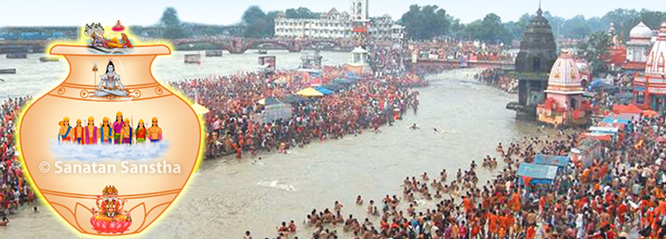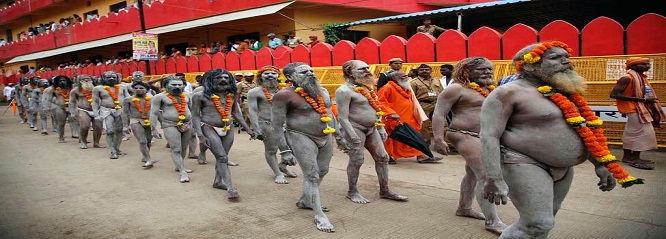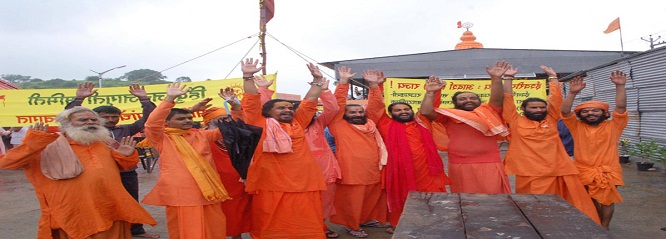The Simhastha Kumbhamela
Nashik-Trimbakeshwar Simhastha Kumbha mela is a Hindu religious mela held every 12 years in the Nashik district of Maharashtra, IndiaThe last Simhastha Kumbhamela was held at Nashik and Trimbakeshwar in the year 2015. Next event of Nashik-Trimbakeshwar Simhastha Kumbhamela in 2027. The Kumbh Festival,a human congregation of spirituality is held at Nashik-Trimbakeshwar, Prayag (Allahabad), Haridwar and Ujjain.

Ardh Kumbh is held at Prayag and Haridwar after every six years.The Kumbh Fair is held at the banks of sacred rivers every 12 years. At Nashik – Trimabkeshwar it is held at the banks of river Godavari. At Prayag it is held at sangam, the confluence of the rivers Ganga-Yamuna and the invisible Saraswati, at the banks of Ganga at Haridawar and at the banks of Kshipra at Ujjain. It is marked by the fact that millions of people participate in this great fair without any summons, call, notice or invitation.
Mythological aspect
Mythological significance of Kumbh revolves around the story of the samudra manthan or ocean churning which was done by the gods and demons to obtain the invaluable ratnas or the jewels and amrita or the nectar. The mountain Mandrachala become churning stick and the Nagraja Vasuki acted as the rope. The Lord Vishnu himself took form of Kasava or tortoise and provided base for the mountain Mandrachala with fear that it may get slipped and submerged in the ocean. The first to emerge in this churning was a venomous poison which was consumed by the Lord Shiva who upon drinking this poison came to be called as the Nilkantha. The churning continues and emerged Kamdhenu, the Uccaishrava Jayanta, the son of Lord Indra , catching sight of the amrita kalasa or the pot filled with nectar, snatched it from the the hands of God Dhanvantari.

Noticing this, Lord Shukracharya , the Guru of demons alerted and demons chased Jayanta. According to the divine counting one day of Gods is equal to the one year of mortal beings and the Jayanta kept on running for 12 days to avoid amrit kalasha to fall in the hands of demons. The four places where Jayanta had put down the amrit kalasha in these twelve years were Haridwar, Prayag, Nashik-Trimbakeshwar and Ujjain, and at these four places at that time the sun, moon ,and planets had reached the unique astrological alignment, during which are kumbhmela is held at these places. The nectar pot was saved from the demons by God Brihaspati with the help of Sun , his son Lord Shani and Moon who saved the nectar kumbh from getting damaged. As mentioned in the Skanda purana, kumbhmela is not just celebrated where the amrit kalasa was put down , but where the nectar had spilled alongwith putting down of the kalasa.
Astro-logical Aspect
The Astrological aspect of Kumbh is related with traversing planets and stars and their certain alignment . As per the Vedas the Sun is considered as a soul like or life giving. The moon is considered as a lord of Mind. The planet Jupiter or Brihaspati is consider as Guru of Gods. As it takes almost 12 years for Jupiter to transverse to complete zodiac , so the Kumbh is celebrated in accordance at one place after about every twelve years. When Jupiter enters in Aquarius or Kumbh ( zodiac sign) and Sun and Moon in Aries and Sagittarius respectively ,Kumbh is held at Haridwar.

When the Jupiter is in Taurus or Vrishabha (zodiac sign) and the Sun and Moon are in Capricorn or Makra, the kumbha is held at Prayag. When the Jupiter enters in Leo or Simha (zodiac sign) and the Sun and Moon in Cancer, the Kumbha is held at Nashik and Trimbakeshwar. When Jupiter is in Leo and the Sun and Moon in Aries, the Kumbha is held at Ujjain. Since Jupiter is in zodiac Simha the Kumbh is held at Trimbakeshwar and Nashik and Ujjain , it is known as Simhastha Kumbh.
The Nashik -Trimbakeshwar Kumbh
This Kumbh is unique as Vaishnav Akhadas and Shaiva Akhadas which bath together at Prayag, Haridwar and Ujjain, baths separately here. As a result of arrangements made by the Peshwas due to clashes between ascetics of both sects , Vaishnva Akhadas baths at Nashik and Shaiva or Sanyasis, Udasin Akhadas baths at Trimbakeshwar. Nashik is believed to be the part of Dandakaranya, where Lord Rama lived during his exile. Trimbakeshwar is one of the twelve Jyotirlingas. The sacred river Godavari originates here on Bramhagiri hills. Trimbakeshwar is having Samadhi of shri sant Nivruttinath who is supposed to be founder of Nath Sampradaya.
Kumbhmela- meaning
Kumbh is a Sanskrit word for pitcher, also referred to as the Kalasha. Kumbh is also a zodiac sign in Indian Astrology for Aquarius. Mela means a gathering or meet or simply a fair. The literal meaning of Kumbh /Ghata is a pitcher, but its elemental meaning is something else. Even as a symbol of pitcher, Kumbh is synonymous with holy activities as in daily life a pitcher (or kalash) is an integral part of all sacred activities in Hindu culture, and this pitcher is a symbol of Kumbh. It is believed and mentioned in Holy Scriptures that mouth (opening) of pitcher symbolizes the presence of Vishnu, its neck that of Rudra, the base of Brahama, all goddesses in the centre and the entire oceans in the interior, thus encompassing all the four Vedas.. The Sanskrit word for Kumbh also means human body . It refers to a womb, bounty,earth, plentitude. It is a receptacle that holds life, spirits, water , Amrita,the elixir. The pitcher ,sea,river, ponds and the well are symbols of Kumbh as the water from these places is covered from all sides. The sky has the cover of the wind, the sun covers the entire universe with its light, and the human body is covered with cells and tissues. The five tatvas / elements – water, earth,fire,sky and wind symbolize the human body. Millions of devotees participate in bathing festival of Kumbh in search of eternal truth which is hidden inside the pitcher. They are bathing to discover one’s own true self, to have a glimpse of knowledge and spirituality which is symbolised by the Kumbh or pitcher.
Elemental Meaning of Kumbh
Kumbh is the confluence of all our cultures,knowledge and spirituality. It is the jamboree of renouncers ( Sanyasis, Vairagis, Udasinas), ascetics (sadhus), saints and holy men to spread the love , unity, knowledge, brotherhood, spirituality. All these values are poured from kumbh, a pot filled with nectar of life, and this kumbh never dries or goes empty. Kumbh make us realize the importance of nature, mother earth through the lyrical flow of holy rivers. It is symbol of confluence of nature and humanity. It rejuvenates the faith and gives eternal energy to our mind and body as Kumbh which never dries.
Earlier the shape of kumbh festival was small. Number of Devotees and Sadhus participating in Kumbhmela are increasing by many folds than the previous Kumbh at each place. Development of infrastructural facilities like transport , modes of communication , etc has facilitated Sadhus and Devotees across the corner of world to participate in Kumbh. It is just not a congregation of peoples or fair, instead it is festival of knowledge, spirituality, asceticism and devotion. Facilities like Sadhugram- dwelling camp, parking, health &sanitation, electric supply and water supply are provided on temporarily for millions of Devotees and Sadhus. Devotees come a long way to participate in Kumbh with utmost faith and with intend of earning holy acts. They are eager to have glimpse of Shahi procession of Akhadas.
Many people come to Kumbh for rendering service to the Sadhus and Devotees , run annachatras, make donations as well as volunteered for services like health, sanitation, divers/life guards etc. The Government and Administration has to also work minutely on each and every aspect of kumbh for the convenience of Sadhus and Devotees.
For More Information Visit – More Info. about Kumbhmela

